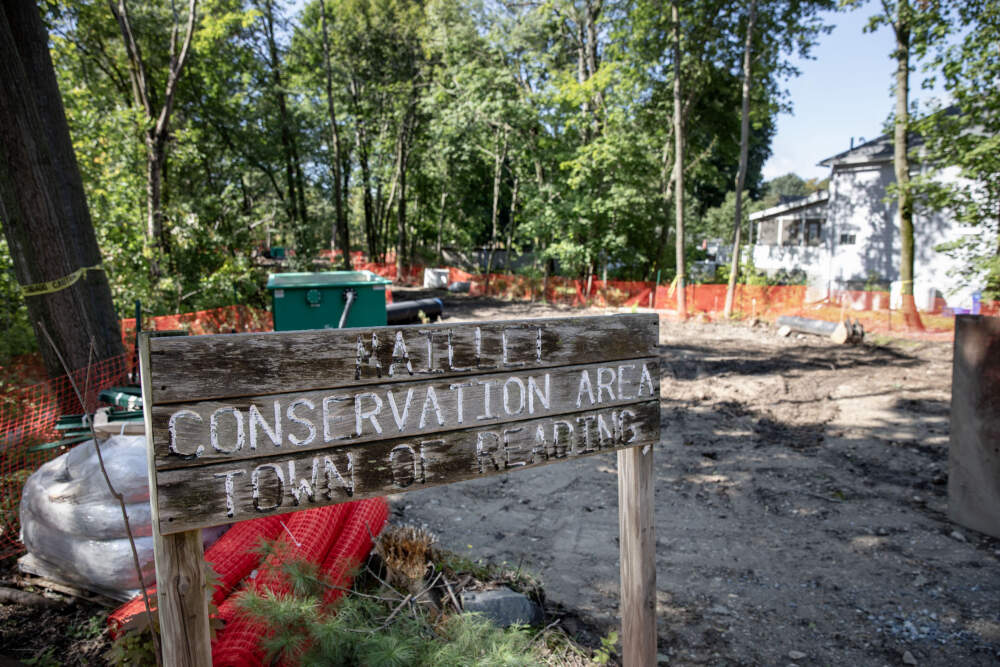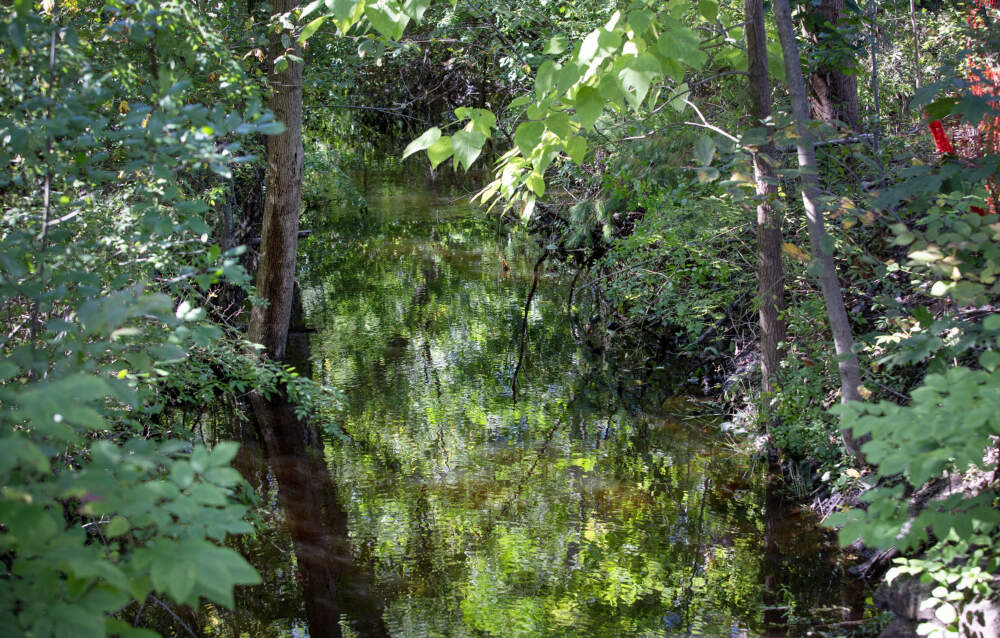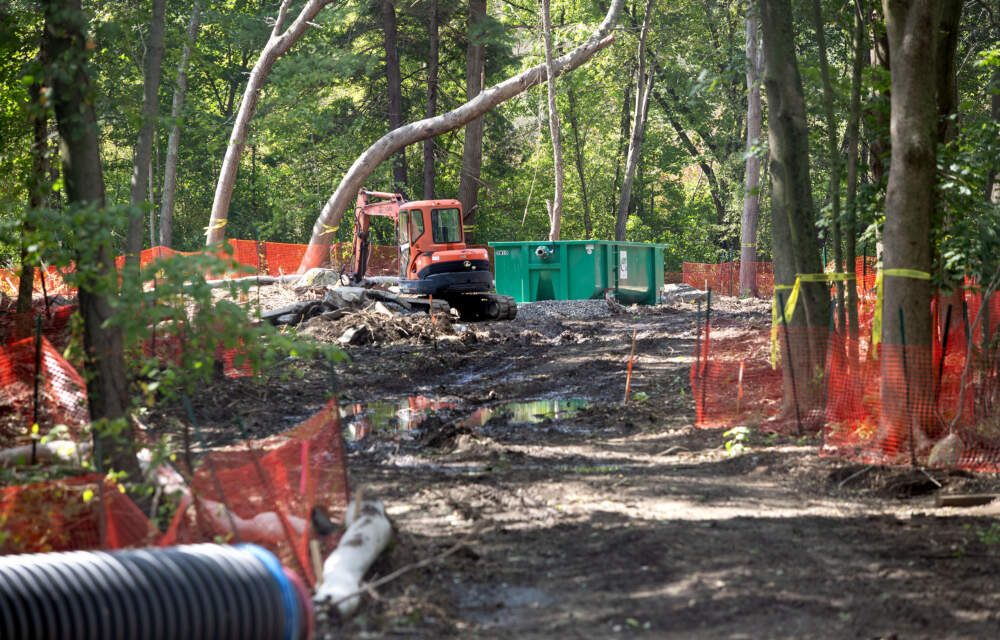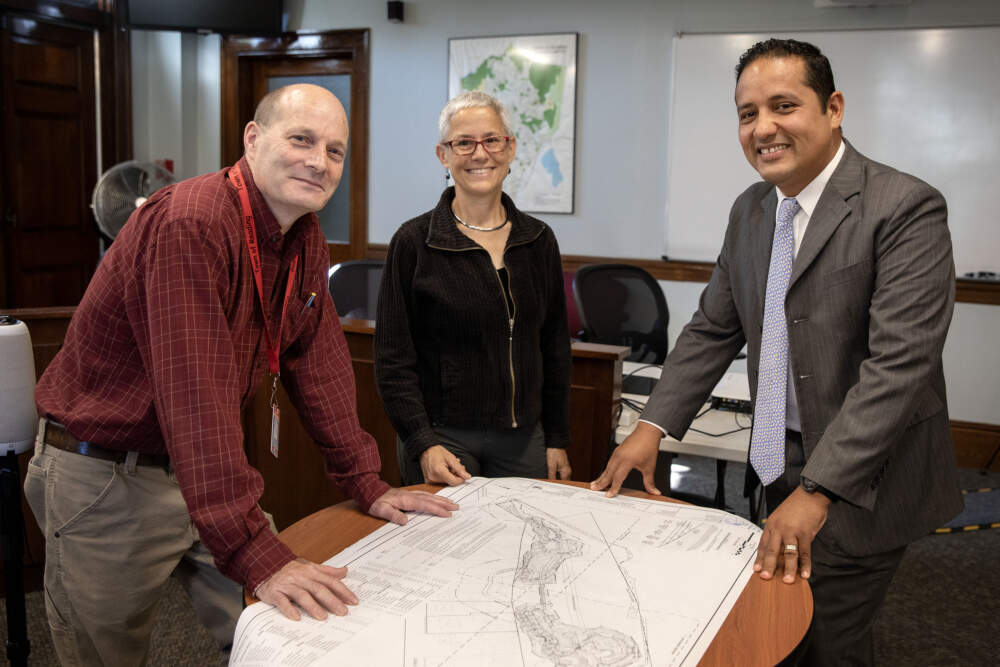Advertisement
In Reading, a solution for local flooding aims to help the whole watershed

It’s been a terrible summer of flash floods across New England. Massive floods tore through Vermont earlier in the season. In Massachusetts, communities like Leominster and North Attleborough had homes and streets damaged in hours, and Boston registered the second-wettest summer in recorded history.
As rainfall is expected to become heavier with climate change, communities are looking for ways to prevent flood damage. Increasingly, that has meant using methods that have worked for thousands of years.
In Reading, one solution has been to literally dig a hole — in fact, several holes: a series of seven ponds that will hold storm water. Some are 10-feet deep. The goal is to avoid flooding in nearby neighborhoods and help slow the flow of water to downstream communities.
“This solution here helps keep the water where water falls. It replicates a natural system,” said Paul Kirshen, a professor of climate adaptation at UMass Boston.
The Mystic River watershed, where Reading is located, is the most urbanized in New England. This means that more surfaces are paved — making it difficult to absorb water when it rains. That’s why building these storm water storage areas can help.
Projects that mimic or expand nature are cheaper to build and maintain, according to Kirshen.
“Before, the solution for dealing with storm water increases would be just to build bigger pipes in the ground, and that is very expensive and just very disruptive and just essentially moves the problem downstream,” he said.
Reading is home to the headwaters of the Aberjona River, a Mystic River tributary. It’s still just a stream when it flows through a culvert below Lowell Street and then through the Maillet, Sommes and Morgan conservation land, where the town contractors are digging the ponds.

The Aberjona’s rapid flow can clog the existing culvert and cause flooding in backyards upstream, said Alex Rozycki, a senior engineer on the project. Water rushing through the culvert also floods downstream toward the forested conservation area and other homes.
In wet months when the ground is already saturated, even one to two inches of rain could flood nearby homes’ backyards. Just upstream of Lowell street, the Aberjona captures storm water from about 40 acres of drains coming from streets, homes and backyards.
Town contractors will divert the culvert flow into the newly built wetlands once the project is complete.
“The water is going to sort of meander and flow through, and kind of fill up. Go to the next pond, fill up, go to the next pond, slow it down, take, take the pollutants out, take the sediment out, and then eventually discharge to the Aberjona,” Rozycki said.
Advertisement
These engineered ponds “will augment the already existing natural function and features of the wetland that's on site,” said Jennifer Relstab, a senior water resources engineer with the Horsley Witten Group, which is working with Reading.

Natural solutions like a wetland help make communities more resilient to climate change, Kirshen said.
They also have other benefits, like cleaning the water. When rain falls on houses, streets and lawns, it picks up pollutants like cigarette butts, debris and dog waste. Two of the ponds will capture larger debris, and plants placed in the ponds will help filter out smaller pollutants.
The wetland will also offer a habitat for frogs, beavers, birds and other wildlife, and a space for recreation for people. The contractors will plant native species that thrive in wetlands and they’ll remove invasive species. Plans also call for constructing a boardwalk and nature overlooks for viewing the ponds and the Thelin Bird Sanctuary nearby.
Massachusetts is investing in these types of nature-based solutions to flooding. Over the past six years, the Executive Office of Energy and Environmental Affairs awarded over $131 million to municipalities through grants from the Municipal Vulnerability Program to help communities adapt to the changing climate. Out of 384 grants, 44 aim to build or improve wetlands in the state.
The project in Reading began construction in July and is slated to finish by June next year. Similar projects in the Mystic River watershed are in the planning stages.
“That's why this project might be so important, because it's a first. And if they can show that it works, we can build more of these. And it’s not only an example for the Mystic but for the Charles River and for the Neponset River,” Kirshen said. “We have to do many more if we're going to really have a measurable impact on the stormwater flooding in the Mystic.”

Along the Mystic River, 20 communities have come together to address flooding in the watershed. The Resilient Mystic Collaborative used a computer model to identify areas in the watershed where a natural solution could help. The wetland project in Reading was high on the priority list.
“We actually had a table of rankings based on: Was it great land to use? Did the landowner want it? Was it close to environmental justice communities? Could we do it quickly? And Reading was one of the absolute highest in the entire watershed,” said Julie Wormser, a senior policy advisor at the Mystic River Watershed Association and co-founder of the collaborative.
The collaborative is helping other cities and towns apply for grants to make a bigger impact on the whole watershed.
“Collectively, we've brought in $61 million, mostly over the last two years, in state and federal funding for projects like these,” she said.

But these projects won’t solve all flooding problems. For example, the wetland in Reading is designed to help alleviate flooding for storms that dump up to 10 inches of rain in a day.
“When you look at what just happened to Leominster, where they got 11 inches in five hours, we've realized that it's not possible to prevent flooding,” Wormser said. “We're really focused on preventing flood damage.”
Rozycki said that while this project will only make a small impact in the overall watershed, it will make a big difference locally.
“What this project really will focus on is reducing that flash, instantaneous flooding,” he said.
He hopes that as more of these natural solutions are constructed, more communities in the watershed will be protected.
This segment aired on October 4, 2023.
